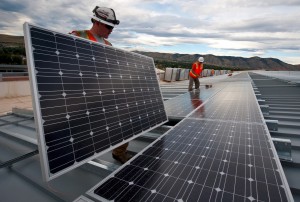Clean Energy Canada | Canada can take clean stimulus lessons from Obama
May 6, 2020

“This is a meaningful, shovel-ready project that will create jobs for local workers.”
This 2009 quote, from then-prime minister Stephen Harper announcing federal stimulus dollars for a new highway passing lane in Nova Scotia, pretty much sums up his government’s approach to pulling Canada’s economy out of recession a decade ago: if it’s ready to go and creates some jobs, write a cheque.
These aren’t inappropriate criteria to use, but considering the billions of dollars that governments spent a decade ago and are poised to spend again post-COVID-19, Canadians would be right to expect more.
With a growing chorus of voices calling for—and more and more governments committing to—putting clean energy and climate action at the heart of economic recovery, one can’t help but wonder if a cleaner approach has been pursued before.
The answer? It has, and the outcome should provide encouragement.
Following the 2008 financial crisis, countries around the world put together stimulus packages with varying emphasis on clean energy. The U.S., under then-president Barack Obama, was one of the largest clean energy spenders, second only to China, apportioning US$112-billion to its clean-energy-focused stimulus. By contrast, Canada spent only US$3-billion.
While Obama’s clean-energy package was just a small portion of the American Recovery and Reinvestment Act, roughly one-eighth of total spending, it packed a punch. Not only did it leverage about $150-billion in private capital, it also created a significant number of jobs in the energy efficiency and renewable energy industries in a short period of time. The clean-energy-related programs supported 900,000 job-years from 2009 to 2015, including new employment for workers from sectors that saw big job losses. Building retrofits and solar panel installation programs re-employed construction workers laid off during the housing crash.
These investments also paid off in reduced carbon pollution: since 2008, U.S. wind generation has tripled, while solar generation has increased more than 80 times. This year, renewable energy will account for 21 per cent of total electricity used in the U.S, contributing to a 28 per cent fall in electricity-related carbon pollution since 2005.
As commentators around the world have noted, we have a once-in-a-generation opportunity to build back better. We don’t have to go back to normal. We can aspire for better than normal.
Let’s ask ourselves: are we building the right projects, with the right materials, in the right way? Beyond being “shovel-ready,” what types of projects are “shovel-worthy?”
For federal officials tasked with wading through, prioritizing, and ultimately green-lighting the programs and projects that will benefit from stimulus funding, clear and comprehensive criteria will be needed. These criteria should allow for robust analysis while also remaining efficient, as stimulus decisions will need to be made swiftly.
The Obama recovery plan and its outcomes can help inform what criteria might be applied to stimulus proposals. What questions should these criteria ask?
First, there is the question of jobs. How many jobs are created per dollar invested? Are they secure jobs in sunrise industries with post-stimulus opportunities?
Second, there is the question of long-term economic impact. Would the investment capitalize on or spur Canadian innovation that might give us a competitive advantage? Would it help create or benefit an existing Canadian supply chain? What are the prospects for leveraging private sector capital?
And lastly, there is the question of climate change. Would the investment encourage cleaner energy and more efficient, productive uses of that energy? Would it contribute to cutting carbon pollution in support of our 2030 climate target and a net-zero 2050?
Government frameworks and datasets already exist to help answer these types of questions, though they are scattered across departments. A concise tool that pulls them together could quickly give us the lens through which we might see a better Canada.
Shovel-ready is well and good, but we have a chance now to build a shovel-worthy decade.
This post was coauthored by Sarah Petrevan and originally appeared in the Hill Times.